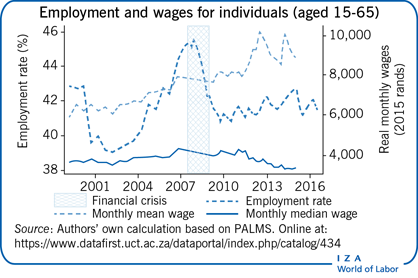Elevator pitch
The South African economy was on a positive growth trajectory from 2003 to 2008 but, like other economies around the world, it was not spared from the effects of the 2008 global financial crisis. The economy has not recovered and employment in South Africa has not yet returned to its pre-crisis levels. Overall inequality has not declined, and median wages seem to have stagnated in the post-apartheid period. Labor force participation has been stable and although progress has been made, gender imbalances persist.

Key findings
Pros
The labor force has become more educated since 2000.
Average earnings increased in the period between 2000 and 2017.
While still substantial overall, the gender wage gap declined at the bottom of the wage distribution and at the mean.
Cons
A low employment rate and stable labor force participation have resulted in high unemployment, especially for youth.
Continued demand for skilled labor and a small tertiary educated labor force have led to very high wages at the top of the wage distribution and worsening wage inequality.
The median worker seems to be the loser in the South African labor market.
While pro-poor policies such as minimum wage laws raise wages at the bottom, high skill premiums have raised wages at the top, leaving median wages stagnant.